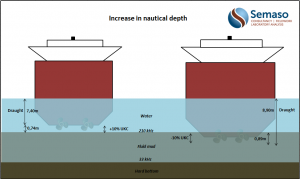Semaso will be presenting at the 10th SedNet conference in Genoa, Italy (Download Abstract).
Maneuvering with negative under keel clearance Results and consequences of field trials in the port of Delfzijl
Van der Made1, C.J., Barth1, R., Verwilligen2, J., Bourgonjen3, L
One of the primary goals of the project Sustainable Port Management is to investigate whether it is possible to optimize the tidal window of the port without a significant increase of the maintenance dredging volumes.
Based on the feasibility study in the first phase of the project it was concluded that, based on the mud conditions at that time, it was realistic to implement the Keep Sediments Navigable (short: KSN) method [1]. This was confirmed by computer simulations with experienced pilots, during which the thickness of the mud layer, the mud density and under keel clearance (UKC) during the runs in the 3D model of the port of Delfzijl were varied [2].
To confirm the maneuverability of ships with negative under keel clearance (UKC) full scale field tests were carried out with a vessel with the following characteristics; length 132m, width 23.6 m, draft 7.4 meter and 2 propellers. During the tests, the vessel’s behavior (use of propeller, rudder, thruster and tugs including corresponding speeds and yaw velocities) was monitored and analyzed in a similar manner as during the computer simulation runs [3].
Before the trials and after each run the in-situ density profiles of the fluid mud were measured at pre-defined locations. Multi beam surveys were performed from this before and after the field trial as well.
Summarizing it can be stated that based on the trial runs an UKCNet between 0% and roughly +14% (up to 20%) the mud layer has a significant influence on the vessel’s behavior, see colored area in figure 2. It should be noted that the current minimum operational UKCGross of +10% is already in the unfavorable range. Based on the trial runs, no reduced maneuverability is expected for an UKC less than +10% to penetration in to the sediment up to an UKC of -5%.







